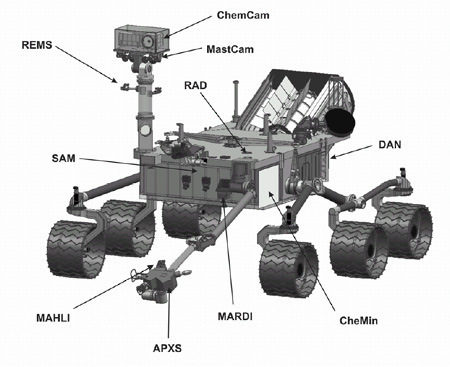Ryan Anderson • Sep 17, 2009
Mars Science Laboratory Instruments: Mastcam
This article originally appeared on Ryan Anderson's "The Martian Chronicles" blog and is reposted here with permission.
A few weeks ago I gave a lunch talk at Cornell summarizing the MSL mission and particularly the instruments that it will carry and was shocked by the number of people who showed up! So, sensing that there is some significant "Curiosity" about the mission, I decided to do a series of posts here. If you are impatient and don't want to wait for me to take my sweet time posting about the instruments one by one, you can read all about them at the MSL Science Corner page. That page is where I will be getting most of the information that I post here, but it is aimed at a more technical audience.
I will start with the color cameras, and the first of those is Mastcam. Mastcam is a pair of cameras on MSL's mast that serve the same role that Pancam does on MER, but it has some key differences. First of all, it is genuinely a color camera, very similar to commercial digital cameras. If you point and shoot with no filter, the resulting image is a color image. Now, if you're like me, when you hear "it works just like your digital camera" you will think for a moment and then realize that you have no idea how a color digital camera works. So here's the short and sweet version:
The detector in a color digital camera is a grid of pixels that are sensitive to light. These pixels have color filters bonded directly to them in a special pattern. Every other pixel has a green filter, and the remaining pixels alternate in rows between red and blue. It's much easier to just show you what I mean:

A computer program is used to interpolate the partial coverage in each color and construct a color image.
Mastcam will also have interchangeable color filters much like Pancam. These filters are mostly for infrared light, and at those wavelengths, the red, green and blue filters that are bonded to the detector are pretty much transparent. So that means Mastcam can be used to take quick color snapshots and to do serious scientific multispectral observations!
Originally, Mastcam was going to be able to zoom in and out, but due to budget problems, that capability was "descoped". Instead, Mastcam now consists of one camera that is permanently "zoomed in" and one that is zoomed out. The zoomed in camera will have a resolution of 7.4 cm per pixel when looking at a target 1km away! When looking at a nearby target (2 m away) it will be able to see things that are ~150 microns, about the size of a small grain of sand. Despite being "zoomed out", the wider-angle camera is also pretty impressive. It will have a resolution of 22cm per pixel at 1km distance and 450 microns for nearby targets. Not too shabby!
As if that wasn't enough, both cameras in Mastcam are capable of taking HD video at 10 frames per second! If you liked the dust-devil movies that MER made, just wait till you see the ones from MSL!
With high resolution color imaging in many wavelengths, MastCam will serve as the eyes for the rover and will allow scientists to study the textures and subtle color variations of the surface. As we have seen with MER, this is a crucial part of understanding the rover's surroundings.
If you would like to read more about Mastcam, check out the Mastcam page within the MSL Science Corner site and the Mastcam page at Malin Space Science Systems (the company that designed and built the color cameras on MSL).
Support our core enterprises
Your support powers our mission to explore worlds, find life, and defend Earth. You make all the difference when you make a gift. Give today!
Donate

 Explore Worlds
Explore Worlds Find Life
Find Life Defend Earth
Defend Earth



